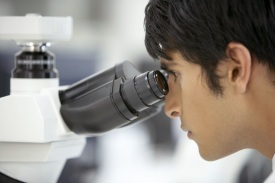Tests That Help Evaluate the Traits of Your Breast Cancer
Your doctor took a sample of cells from your breast using a biopsy to confirm that you have cancer.
If cancer is found, your doctor may request other tests to learn more about your specific type of cancer, its exact location, how far it has spread, and how fast it is growing. This will help determine which treatment is likely to be most effective for you. You may have one or more of the following tests:
Lab tests

More lab tests may be done on the sample of cells that was taken during your breast biopsy. From these tests your doctor will learn whether the tumor needs certain hormones to grow. Tumors that need hormones to grow are called hormone-receptor positive (HR+) because they have receptors for either estrogen or progesterone. Another test is done on the biopsy sample to see if the cancer cells produce another receptor called the human epidermal growth factor receptor 2, or HER2. Tumors that produce a lot of this receptor are known as HER2-positive and tend to grow more aggressively. However, "triple-negative" breast cancers, which don't have any of these 3 receptors, have a worse prognosis. Knowing the receptor status of the breast cancer helps predict how quickly the tumor might grow and guides the treatment plan.
Magnetic Resonance Imaging (MRI)
An MRI uses strong magnets and radio waves to produce pictures that are cross-sectional “slices” of your body from many different angles. Because of its sensitivity in finding breast abnormalities, an MRI is sometimes used to help decide whether just the tumor should be taken out with a lumpectomy or if the whole breast should be removed with a mastectomy.
During an MRI of your breast, you’ll lie on your stomach on a specially designed scanning table. The table has openings for each breast to hang into to prevent the breasts from being compressed during the test. The table is then moved into a tubelike machine that contains the magnet. After a series of images have been taken, you may be given a contrast agent through a needle in your arm to help your doctor see the tumor. The contrast agent is not radioactive. More images are then taken. The entire session takes about 1 hour.
MRIs are also used to see if cancer has spread outside of the breast to the spine and brain. For these images, you lie face up and still on a table inside a narrow cylinder while the machine creates images of your spine and brain.
Computed Tomography (CT)
During a CT scan (also called a CAT scan), X-rays scan the entire chest in about 15 to 25 seconds. These X-rays are 100 times more sensitive than those of a typical X-ray. When you have breast cancer, these pictures help your doctor see where the cancer is located in your breast and whether it has spread to your lymph nodes, liver, or other organs. It can also be used to help guide the needle during a biopsy. To have the test, you lie still on a table as it gradually slides through the center of the CT scanner. Then the scanner rotates around you, directing a continuous beam of X-rays at your chest. A computer uses the data from the X-rays to create many pictures of your chest, which can be used together to create a three-dimensional picture. A CT scan is painless. You may be asked to hold your breath one or more times during the scan. In some cases, if the scan includes your abdomen, you will be asked to drink a contrast medium 4 to 6 hours before the scan. You may be asked not to eat anything during the time between drinking the contrast and having the scan.
Bone Scan
This test shows whether cancer has spread to your bones. For this test, you’ll be injected with a small amount of radioactive substance. This substance will travel through your bloodstream and collect in areas of abnormal bone growth. Pictures are taken with a special camera and any spots that show up may be caused by cancer. Spots may also light up due to things like arthritis or infection and will need to be investigated further. The bone scan is the most sensitive technique currently available for identifying breast cancer that has spread to the bones.
Positron Emission Tomography (PET)
PET scans work differently from other imaging tests. They can actually measure body chemistry, making them helpful for evaluating small “hot spots” of cancer. They can help your doctor figure out where in the body the breast cancer has spread. Because these tests scan your whole body, your doctor may order a PET scan instead of ordering multiple X-rays of different parts of your body. For this test, you will get injected with sugar (glucose) that contains a mildly radioactive substance. Because cancer cells are more active than healthy cells, they absorb more of the radioactive sugar. About an hour after the injection, you will lie still on a table inside the PET scanner while it rotates around you, taking pictures of the radioactive glucose hot spots. The machine will rotate around you 6 or 7 times, and the entire scan takes about 45 minutes. A PET scan is painless. But if you’re sensitive to the sugar, you may have nausea, headache, or vomiting.
Schedule a Mammogram at Richmond University Medical Center
Early detection and treatment is the best strategy for a better cancer outcome. Schedule your mammogram at RUMC: Call 718-818-3280.
Kathy Giovinazzo is Director of Radiology at Richmond University Medical Center.
For More Information
For more information or to schedule an appointment, contact Dr. Thomas Forlenza at 718-816-4949. His office is located at 1366 Victory Blvd on Staten Island.
Dr. Forlenza is the Director of Oncology at Richmond University Medical Center.